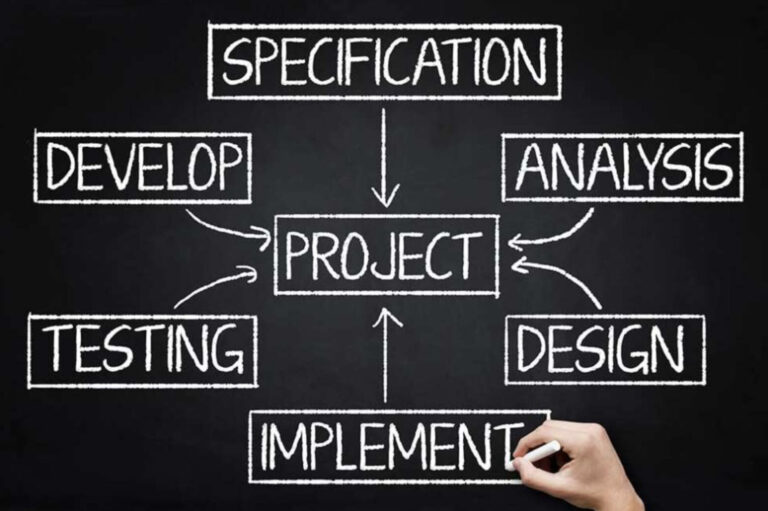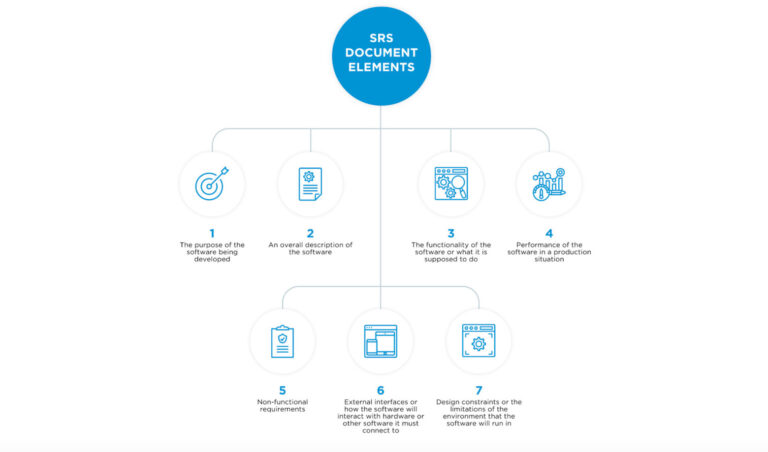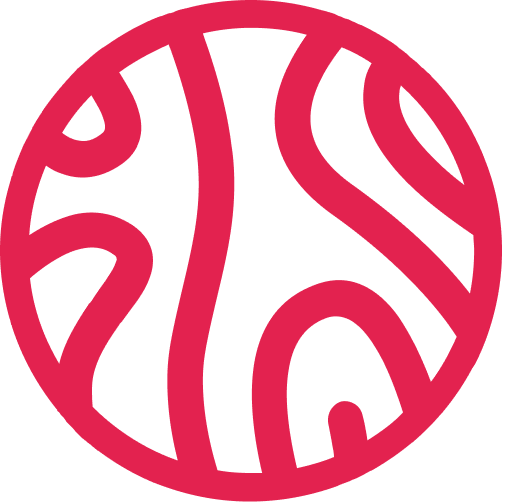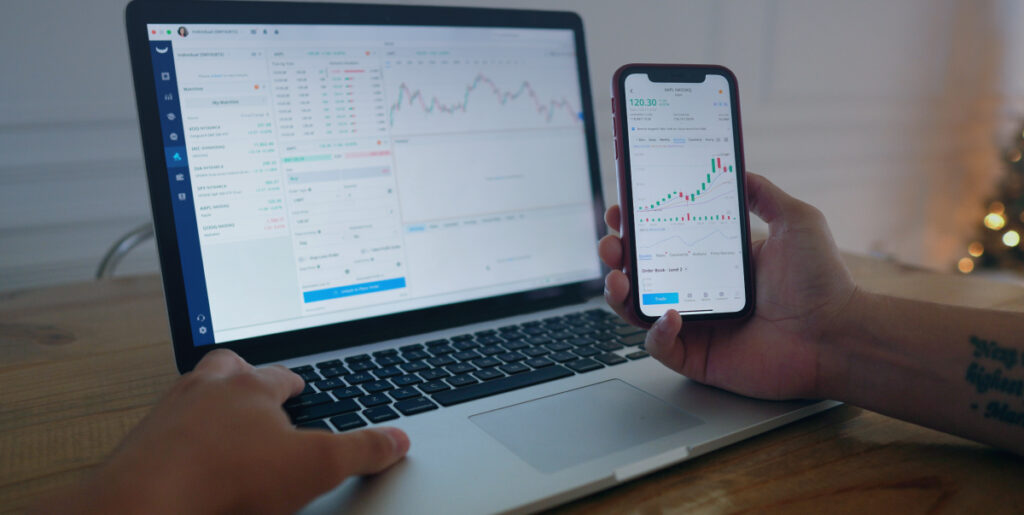Table of Contents
Every custom software project, like every construction project, needs a perfect specification to succeed. But it takes a lot of time and patience to write down all the details on paper.
Attention to detail and mindfulness will help a lot.
It must be acknowledged that specifications (Software Requirement Specifications) are even more important if you’re going to outsource software development.
This is your guiding document, sacred tablets, and an ultimate protection insignia if any misunderstandings with the development team occur.
Writing down a mobile app specification document is the mandatory step for any software development project. So, why so much fuss over it?
But before it, we would like to talk about the pre-development stage and why we won’t start any project without it.

Why should your mobile app development project pass through the Discovery phase?
They say that getting started is half the battle, but there is a preparatory stage for launching a project in software development.
At this stage, the idea is formed, market research and similar proposals are carried out. This stage is called the discovery phase.
The opening phase is designed to answer critical questions
- Is the idea possible?
- Will the product stand up to the competition?
- How do you make it relevant to end-users?
Let’s take a quick look at the discovery phase and why it is so important in software development. You can read more about this phase in the article Why is the discovery phase a must for every project?.
Whatever you represent (a startup or a successful company in need of digitalization), based on our experience, you need to dive into the opening phase, even if you think you know everything about your business, future applications, and potential users.
Also, holistic research and information gathering can help you identify and eliminate all possible risks.
The business discovery phase helps you understand end-users, their needs, and requirements. The technical knowledge part of the process leads to a System Requirements Specification (SRS) with information on the development and app legal requirements.
Let’s talk about it in more detail below.
Depending on the project’s size, the opening phase can last from one week to two months. The business analyst and account manager take the lead in the discovery phase.
Sometimes, team leaders, developers, or designers may join the work. They help with SRS, wireframe prototypes, or scope.
The Discovery Phase is a crucial pre-development phase and is best left to a team of professionals with years of market research experience.
Yes, this service will cost you a little money, but by investing in such research, you are investing in the demand, competitiveness, and overall success of your project in the market.

Software requirement specification document
Definition of Software Requirements Specification – SRS is a document that contains information about the functions and goals of the future digital solution and its principles of operation.
Based on this document, the entire process of developing a software product is built and followed by all participants in the development process; based on it, the app design is done, and development is carried out.
Checklists are written on its basis (which determines the conditions for accepting the finished product).
Based on SRS, the project manager can separate bugs from additional app’s functionality (which allows expanding the project budget).
Goals of software requirements specification document
The SRS is necessary for all structural units of the development team: Project Management, Software Development, Quality Assurance, Client, and Business Development.
Thus, specification perceives 5 main goals:
- Facilitate review of the project and describe the scope to the team.
- Give starting references to UI/UX designers, software architects, and team leads.
- Provide clear modules of software for testing use cases based on the set number of goals.
- Provide an additional reference layer for code review and code refactoring.
- Create a wireframe for further work so the client can easily integrate additional system features later on.
What is the difference between functional and non-functional requirements?
The functional requirement describes the system’s behaviour in relation to its functionality, while the non-functional requirement elaborates on app performance characteristics.
This article explains the difference between them.
Non-functional requirements are sometimes defined in terms of metrics (i.e., something that can be measured about the system) to make them more tangible.
Non-functional requirements may also describe aspects of the system that don’t relate to its execution but rather to its evolution over time (e.g., maintainability, extensibility, documentation, etc.).
General requirements for the app’s specification

Software requirements establish the necessary agreements between users (customers) and developers (implementers) about what the system will do and what should not be expected.
The document may include procedures for checking the received software for compliance with its requirements (up to the content of test plans).
These characteristics determine the quality and methods of its assessment, security issues, and much more. Often, the software requirements are written in plain language.
At the same time, there are semi-formal and formal methods and approaches used to specify software requirements.
In any case, the challenge is to ensure that the software requirements are precise.
The relationships between them are transparent. This specification’s content does not allow for discrepancies and interpretations that could lead to the creation of a software product that does not meet the needs of stakeholders.
The following elements distinguish the right specification
- An emphasis on details and their clear definition.
- Taking care of misinterpretation.
- Consistency within this specification and other specs.
- The logical relationship of components.
- The comprehensiveness of the subject.
- Compliance with regulations.
- Compliance with business practices.
It should be noted that system design elements should not be included in the requirements documentation.
However, Use Cases are often included in the requirements specification, along with diagrams tracing to the corresponding models.
When it comes to writing requirements specifications, keep in mind that specifications do not include the graphical user friendly interface design details, such as button colours and or font appearance.
There is prototyping for that.

Several mandatory sections must be in any app specification document. Those parts form a structure of any specification and ease the navigation across the document.
Introduction
- The scope of the document.
- Short description of the project.
- All terms & definitions of specific to the following app.
General requirements
- System requirements (OS platforms, browser versions).
- Formats (date, time, currency, language, etc.).
- Wireframe structure, pagination, imagery, etc.
Functions
- (notifications, emails, alerts, actions that app preforms).
External Integrations
- (payment system, analytics integration).
Roles
- (admin, users, moderator, etc.).
Entity vocabulary
Use cases for every role
In addition to these must-have chapters, the app’s specs can also contain specific design constraints, assumptions, and security, performance, or database structure requirements.
Requirements smells
You’ve probably heard of code smells. Following this idea, the project manager, team leads, and architects also proposed the idea of Requirements Smells.
These are usually wordings and text parts that are too vague to be transferred into structured code:
- No specific and definite results.
- Abound in adjectives.
- Subjective language.
- Negative statements.
To eliminate those non-technical statements out, the Business Developer writes specs in close cooperation with the Project Manager, Team Lead, and the Software Architect’s supervision.
How to write software requirements specification
It is easy to define what SRS is and point out what should be in it. But it is surprisingly hard to write down all those things partly because there are too many participants involved in the process: the client, business developer, and software architect to start.
Also, it is tough to transfer someone else’s ideas into a definite and strict text document.
Plus, it would help if you wrote SRS in a technical and sometimes by using indications on how the program should behave from the developer’s point of view.
That is why our company has dedicated professionals in charge of specification development.
By default, they are involved in the process right from the first moment you contact development teams. You don’t know them yet.
Need a software requirements specification example?
Three Contacts
- On an estimation stage, you communicate only with the Sales Manager.
- Once you order SRS, we will put you in direct contact with our business developer.
- Once your specs are finished, we will introduce you to the project manager.
The development of software specifications starts from the very first time you contact our team and describe your idea.
The communication process behind the scene
- You contact us.
- We sign the NDA.
- Our Client Manager structures your inquiry.
- HIDDEN Provides the information to the Software Architect and Business Developer.
- The client Manager requests you for the additional scope to develop a better quote.
- HIDDEN Software Architect and Business Developer prepare the first project estimation.
- We provide you with a quote.
- HIDDEN: Every time you supply us with new information, it goes to the Business Developer and Architect.
- You refine your inquiry, provide additional details, and describe your goals.
- HIDDEN Our specialists constantly optimize your project to achieve the goals, taking less time for development.
- You get a refined quote and request an SRS for your project.
- We put you in contact with our Business Developer, who is already familiar with your project, so you can get right from where you’re now.
- Business Developer makes clarifying questions and transfers the project in a technical language.
- HIDDEN Business Developer constantly consults with the Software Architect to find the most elegant software solutions to achieve your goals.
- HIDDEN Closer to the end of the process, our Client Manager contacts the Project Manager and books suitable software developers required for the project.
- HIDDEN Project Manager familiarizes with the specifications and makes clarifying questions if needed.
- Software Requirements Specification is completed.
- HIDDEN: Our Software Architect and Project Manager prepare the final project quote based on the completed specs.
- You get the final project quote.
- If you choose to develop the project with us, we will introduce you to the Project Manager and the team, and you’ll be ready to start app development.
That’s how our team’s communication process goes from the first contact with our client to the software development itself. As you may notice, a Business Analyst gets involved in the process as early as the first contact occurs.
Why is a properly written app spec crucial for project success?
Let’s pretend you have an idea for a mobile app, but you don’t have a development team, and you don’t have a lot of app development skills. After a specific search, you have found specialists and want to explain your idea to them.
If you start describing your application in general terms, you may be disappointed with the result without much specifics and set goals.
Why? When describing your idea, there weren’t enough details for the developer to truly understand your concept.
Everything in your thoughts can be quite clear and understandable, but you need to consider that developers do not read the minds and will most likely create your solution based on their experience.
Thus, each of you will have a different idea of what the application will be like.
Therefore, the best way to clarify everything is to write down all your requirements and describe how you envision the result.
After you share with the developer, you can start a discussion to ensure both of you are on the same page.
The SRS document helps you communicate your idea in a structured way so that important details are not overlooked.
Specifications should be translated into a language that developers can understand. In our company, the role of a translator is performed by a Business Analyst.
The SRS document describes what the client wants and what the developers will provide.
Having a clear set of requirements ensures that the development team creates software that meets the customers’ needs.
SRS will help you estimate the cost of work and cover the scope of the project.
It also gives developers the technical stack insight they need and helps them plan their work, but that’s not all
- Designers gain insight into a project through SRS documents to align the design with the use case.
- Testers receive guidance on how to create test cases that meet business needs.
- End-users use the SRS to understand software.
- It provides investors with an overview of the system’s capabilities so that they can make investment decisions.
The SRS is crucial because it is a single source of information and expectations that prevent misunderstandings between project managers, developers, designers, and testers.
To conclude
Developing mobile apps without an SRS can be challenging!
Of course, software specifications require certain costs at the start, but they help avoid higher costs at later stages of the project.
Suppose the development company you turned to for creating the project does not offer you to start the process without specifications.
In that case, this indicates a lack of competence and little experience in development. This approach can lead to problems in working on your product.
We recommend that you find someone more qualified and experienced. Altamira pays great attention to the specification stage and involves all team members required to make them flawless.
FAQ
And we also believe that using wireframes at the stage of drafting specs is essential since illustrations improve the understanding of the specifications’ text. Moreover, if more than four wireframe screens are planned, we can draw a map of the screens to avoid confusion.
Many wireframe tools can help you communicate your point of view: Axure Balsamiq Figma InDesign CC Microsoft Visio Photoshop CC UXPin User Stories can also be used to tell the developer what the application will be doing.
Alternatively, you can use different approaches to creating an application specification document. It is only essential to keep it simple and understandable for all participants in the process. The ground rules should be clear and consistent while avoiding general requirements that can be considered uncomplicated.
There is no significant difference. The main difference is the different names of the elements. A standard dictionary solves this problem by referencing the elements that are meant by it and the different default behaviors.
For instance, Android in default mode includes notifications iOS in default mode asks the user to confirm that he wants to receive notifications It is prescribed in the specifications as a criterion only for iOS. However, understanding Android app development 101 is extremely important for defining clear and effective software requirements that guide the entire app development process.
Usually, it takes around 2 weeks to finish all steps of the discovery phase. However, this period can be extended for up to 3 weeks depending on the project complexity.



